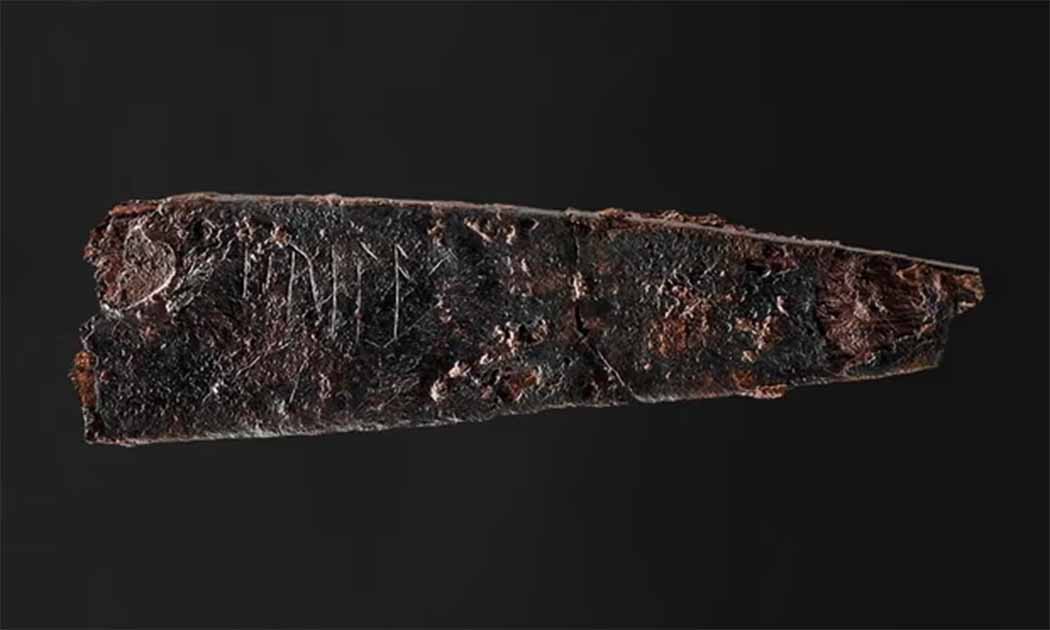Denmark’s Oldest Runic Inscription Found on the Blade of a 2,000-Year-Old Knife
The discovery of a runic inscription on an almost 2,000-year-old knife sheds light on Denmark's early written language and cultural history – it’s the oldest runic inscription found so far in the country. The knife was found beneath the remains of an urn grave at a small burial site east of Odense.
The details about the runic inscription on the 8 cm (3 inch) iron knife contains five characters, each 0.5cm (0.2 inch) tall with three grooves. The runes are thought to spell out " hirila," meaning "little sword" in Primitive Norse. They’re 800 years older than even the famed Jelling Stones runes of Jutland!

The runes are traced out on the graphic shown here from Montergarden Museum, Odense. (Montergarden Museum)
Oldest Runes Ever Found: A Note from Beyond
The discovery of the runic inscription on the iron knife, along with an inscribed bone comb found nearby in 1865, represent the oldest runes ever found in Denmark. The account was provided by Jakob Bonde, the city's museum curator and archaeologist, who said the runes were not visible until after the artifact underwent cleaning by conservators, reports The Viking Herald.
“It’s like getting a note from beyond, from the past. It’s an extraordinary find for us and it says something about the development of the earliest Scandinavian language. And for me personally it’s fantastic to have made this discovery,…With a discovery like this in hand, humans get to experience coming face to face with the past. A runic inscription is like finding a message from ancient people. You can almost hear their voices… a fantastic opportunity to connect the past with the present,” commented Bonde.
- Runes of Power and Destruction: Reading the Cursed Runestones of Sweden
- The Mystery, Magic and Meaning of Viking Runes

The inscription is on the 8 cm section of knife blade, shown here held by museum inspector Jakob Bonde. (© Museum Odense)
Runes were the written characters used by Germanic peoples, including the Scandinavians, before the adoption of the Latin alphabet. They contribute to the understanding of the linguistic and cultural practices of the region during that period. The use of runes in this context may have served a practical purpose, such as indicating the item's function or importance.
Lisbeth Imer, from the National Museum, added, “It is incredibly rare that we find runes that are as old as on this blade, and it is a unique opportunity to learn more about Denmark’s earliest written language that was actually spoken in the Iron Age.”
- The Runamo Runes: The Mysterious Runic Inscription that Never Was!
- Earliest Runestone Inscription Discovered in Norway

The other side of the knife is decorated with what looks like a face and chevron pattern. (© Museum Odense)
High-Status Elite: A Glimpse of Danish History
Information regarding the owner of the grave remains largely unknown. The discovery provides valuable clues about the material culture and language of the time; the chronological significance of the knife, believed to be 800 years older than the Jelling stones, is remarkable.
The Jelling stones are renowned for their historical importance, often referred to as "Denmark's birth certificate," as they commemorate King Harald Bluetooth's achievements and include Scandinavia's oldest image of Christ. The newly discovered runic inscription predates these stones, providing a rare glimpse into an even earlier period of Danish history, reports The Heritage Daily.
The exhibition of the knife alongside other artifacts at Møntergarden Museum in Odense offers an opportunity for the public and researchers to further explore and appreciate Denmark's rich archaeological heritage.
In the era under consideration, widespread literacy was uncommon, and the possession of reading and writing skills conferred a particular status and influence. The early use of runes indicates that a select group of individuals, serving as scribes and forming a small intellectual elite, were among the earliest in Denmark to wield such capabilities. The earliest traces of individuals with these skills have been identified on the island of Funen, reports Arkeonews.
Only one additional instance of runic inscriptions from this period has been uncovered in Denmark, dating to approximately AD 150. This discovery took the form of a small bone comb found in Vimosen, situated west of Odense, featuring the inscription " harja."
Interestingly, this period of Danish history also had deep connections with the Romans, who influenced the way the elite used to dress and look. “We are in a period of time where we in Denmark had a lot of connection with the Romans and the ones who were high[ly] placed in society tried to look Roman, so to speak, by importing things and making a Roman display of themselves. Everything Roman was very in,” concluded Bonde.
Top image: The 2,000-year-old iron knife, found near Odense on the island of Funen, Denmark, carries the oldest runic inscription known. Source: Rogvi N Johansen/© Museum Odense
By Sahir Pandey
References
Kayra, O. 2024. An engraving on an almost 2,000-year-old knife believed to be the oldest runes ever found in Denmark has been discovered by archaeologists. Available at: https://arkeonews.net/an-engraving-on-an-almost-2000-year-old-knife-believed-to-be-the-oldest-runes-ever-found-in-denmark-has-been-discovered-by-archaeologists/.
Milligan, M. 2024. Denmark’s oldest runic inscription found on knife blade. Available at: https://www.heritagedaily.com/2024/01/denmarks-oldest-runic-inscription-found-on-knife-blade/150302.
Radley, D. 2024. 2,000-year-old knife with Denmark’s oldest runic inscription discovered on Funen. Available at: https://archaeologymag.com/2024/01/knife-with-denmarks-oldest-runic-inscription-discovered-on-funen/.
Bryant, M. 2024. Engraving on 2,000-year-old knife thought to be oldest runes in Denmark. Available at: https://www.theguardian.com/science/2024/jan/22/engraving-on-2000-year-old-knife-thought-to-be-oldest-runes-in-denmark.
Cresswell, P. 2024. Oldest runes ever discovered in Denmark found on the island of Funen. Available at: https://thevikingherald.com/article/oldest-runes-ever-discovered-in-denmark-found-on-the-island-of-funen/795.

















